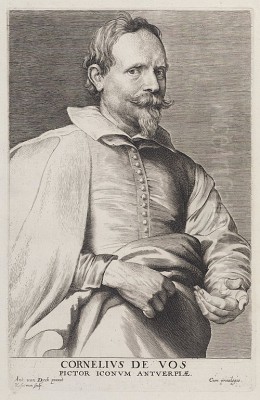
Cornelis de Vos stands as a significant figure in the rich tapestry of Flemish Baroque painting. Active during the first half of the 17th century, primarily in Antwerp, he carved a distinct niche for himself, particularly excelling in the art of portraiture. While often discussed in the context of his towering contemporaries, Peter Paul Rubens and Anthony van Dyck, De Vos possessed a unique artistic voice characterized by sensitivity, warmth, and a remarkable ability to capture the burgeoning prosperity and familial values of Antwerp's citizenry. His contributions extend beyond portraiture, encompassing historical and religious scenes, often realised through fruitful collaborations that were typical of the Antwerp art scene.
Early Life and Artistic Formation in Hulst and Antwerp
Cornelis de Vos was born in Hulst, near Antwerp, in what was then the Spanish Netherlands (now Zeeland in the Netherlands), likely around 1584 or 1585. His family relocated to Antwerp by 1596, a city that was rapidly re-establishing itself as a major European economic and artistic hub after the turbulence of the Dutch Revolt. This move placed the young Cornelis at the epicentre of a vibrant artistic milieu, offering unparalleled opportunities for training and patronage.
Details about his earliest training remain somewhat scarce, but it is documented that he was apprenticed to the relatively obscure painter David Remeeus (also spelled Reymers) around 1599. De Vos likely spent several years honing his fundamental skills under Remeeus before establishing himself independently. By 1608, his training was complete, and he achieved a crucial milestone by becoming a master in the prestigious Antwerp Guild of Saint Luke, the city's official body governing painters, sculptors, printmakers, and related trades. Membership was essential for operating an independent workshop and taking on apprentices.
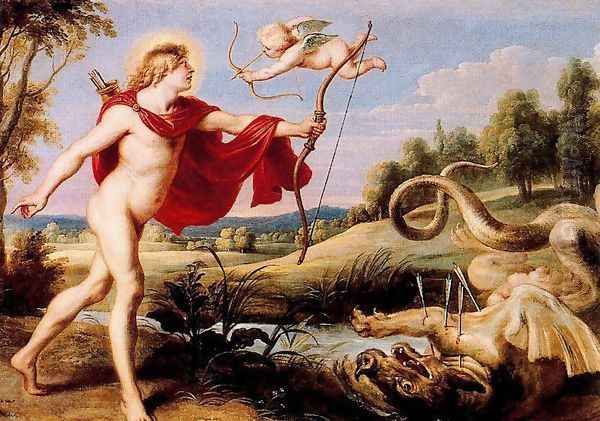
In the same year, 1608, De Vos also became a citizen (burgher) of Antwerp, further solidifying his position within the city's social and economic structure. His early career seems to have progressed steadily, building a reputation within the local community. He initially also engaged in art dealing, an activity not uncommon among Antwerp artists, including giants like Rubens, leveraging their expertise and networks to trade in artworks. This dual role provided financial stability and kept him deeply connected to the evolving tastes and demands of the art market.
The Antwerp Milieu: A Crucible of Talent
To fully appreciate Cornelis de Vos's career, one must understand the extraordinary artistic environment of Antwerp in the early 17th century. Following the Spanish Fury and the subsequent exodus of many Protestant citizens, Antwerp, under the rule of the Archdukes Albert and Isabella, experienced a Catholic resurgence and a period of relative stability known as the Pax Hispanica. This fostered a climate of renewed patronage from the Church, the aristocracy, and increasingly, the wealthy merchant class.
Antwerp became a powerhouse of Baroque art, dominated by the genius and prolific output of Peter Paul Rubens. Rubens's workshop was a major enterprise, attracting talent from across Flanders and influencing virtually every artist in the city. Alongside Rubens, Anthony van Dyck emerged as a prodigy, initially working with Rubens before achieving international fame as a court portraitist. Other major figures included Jacob Jordaens, known for his robust genre scenes and mythological paintings, and specialists like the animal painter Frans Snyders and the landscape artist Jan Wildens.
This concentration of talent created an environment of both intense competition and frequent collaboration. Artists often specialized and worked together on large commissions, combining their respective skills. De Vos navigated this complex scene successfully, establishing his own distinct identity while maintaining productive relationships with his peers, most notably Rubens himself. His ability to thrive amidst such formidable contemporaries speaks volumes about his skill and adaptability.
Development of a Distinctive Style: Influences and Individuality
Cornelis de Vos's artistic style evolved under the pervasive influence of Antwerp's leading masters, yet he synthesized these influences into a personal idiom. The impact of Peter Paul Rubens is evident in the compositional dynamism and rich, albeit often warmer and more subtly modulated, colour palette seen in some of De Vos's works, particularly his history paintings. Rubens's energetic brushwork and dramatic flair, however, are generally tempered in De Vos's approach.
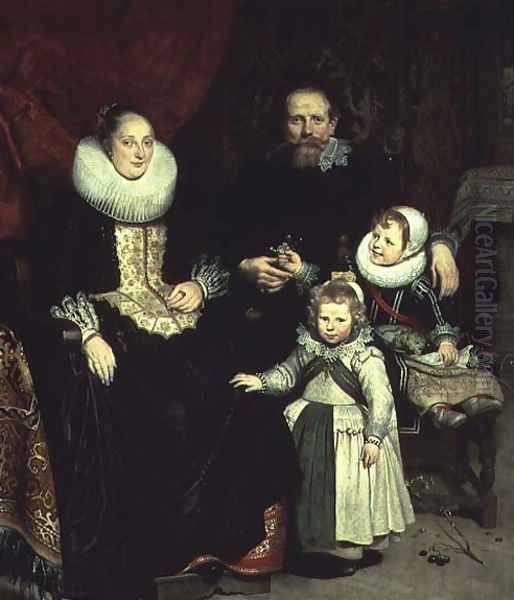
The influence of Anthony van Dyck is perhaps even more pronounced, especially in portraiture. De Vos absorbed Van Dyck's elegance, his sophisticated rendering of fabrics, and his ability to convey the sitter's status and psychological presence. However, De Vos often brought a greater sense of intimacy and warmth to his portraits, particularly those of families and children. Compared to Van Dyck's often aristocratic reserve, De Vos's sitters can appear more approachable, grounded in the comfortable reality of bourgeois life.
Beyond these dominant figures, De Vos's work also reflects the enduring Netherlandish tradition of meticulous realism and attention to detail, inherited from predecessors like Jan van Eyck and Hans Memling, albeit translated into a Baroque context. He excelled at rendering textures – the sheen of silk, the intricate patterns of lace, the softness of velvet – grounding his figures in a tangible reality. His colour palette often favoured warm harmonies, with rich reds, golds, and browns balanced by cooler greys and silvers, contributing to the overall sense of warmth and refinement. He demonstrated a keen sensitivity to light, using it to model form effectively and create a gentle ambiance.
Master of Portraiture: Capturing Antwerp's Elite
While adept in various genres, Cornelis de Vos built his most enduring reputation as a portrait painter. He became one of the most sought-after portraitists in Antwerp, particularly favoured by the city's affluent merchant families. His success in this field stemmed from his ability to balance truthful representation with a flattering sense of dignity and prosperity, perfectly meeting the aspirations of his clientele.
His individual portraits showcase his skill in capturing likeness and character. He paid meticulous attention to the details of costume and accessories, which served not only as markers of wealth and status but also added visual richness to the compositions. Sitters are often presented in three-quarter view, engaging the viewer with a direct yet composed gaze. Works like the Portrait of Abraham Grapheus (1620, Royal Museum of Fine Arts Antwerp) are exceptional. Grapheus, the messenger of the Guild of Saint Luke, is depicted with striking realism, adorned with the symbols of his office, creating a powerful and memorable character study.
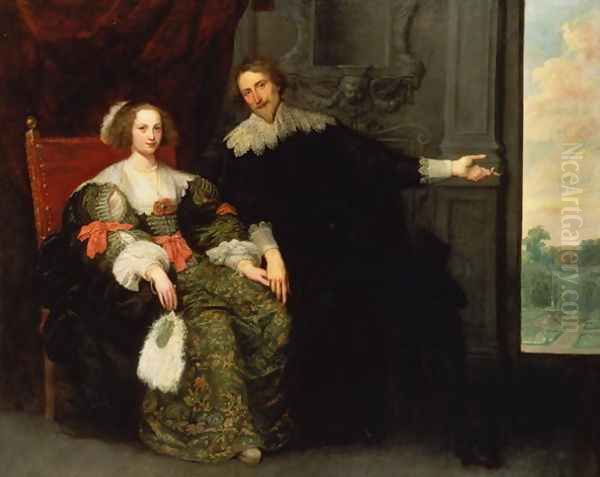
De Vos particularly excelled in group portraiture, especially depictions of families. These works offer fascinating glimpses into the domestic world and values of the Antwerp bourgeoisie. He arranged family members, often including numerous children, in compositions that feel both formal and intimate. A prime example is his own Self-Portrait with his Wife Susanna Cock and their Children (c. 1621, Royal Museums of Fine Arts of Belgium, Brussels). This painting radiates familial warmth and pride, showcasing the artist's prosperity and his affection for his family, rendered with characteristic sensitivity and detailed execution.
The Tender Gaze: Portraits of Children
Cornelis de Vos possessed a particular gift for portraying children. In an era when children were often depicted as miniature adults, De Vos captured their youthful innocence, vulnerability, and burgeoning personalities with remarkable empathy. He seemed genuinely interested in their individual characters, moving beyond mere representation to convey a sense of their inner lives.
His portraits of children, whether individually or as part of family groups, are among his most appealing works. He rendered their delicate features, soft hair, and elaborate costumes with exquisite care. Examples like the Portrait of Magdalena and Jan Baptist de Vos, the artist's own children (c. 1622, Royal Museum of Fine Arts Antwerp), show them looking directly at the viewer with a charming seriousness. He often included pets or toys, adding touches of informality and highlighting the children's world. This sensitivity set him apart and contributed significantly to his popularity among patrons eager to immortalize their offspring. His approach influenced later Flemish painters dealing with similar subjects.
History Painting and Collaboration
Although primarily known for portraits, De Vos was also active as a history painter, tackling mythological, biblical, and allegorical subjects. These works often formed part of larger decorative schemes for churches, civic buildings, or private residences, frequently involving collaboration with other artists. The Antwerp system encouraged such partnerships, allowing complex projects to be completed efficiently by leveraging individual specializations.
De Vos maintained a close working relationship with Peter Paul Rubens. He was one of several artists Rubens enlisted to assist with large-scale commissions, demonstrating Rubens's respect for his abilities. Notably, De Vos contributed paintings based on Rubens's designs for the decorations celebrating the triumphal entry of Cardinal-Infante Ferdinand into Antwerp in 1635. He also worked on the massive cycle of mythological paintings, again after Rubens's sketches, for Philip IV of Spain's hunting lodge, the Torre de la Parada, near Madrid (1636-1638). His painting Apollo and the Python (Prado Museum, Madrid) originates from this commission.
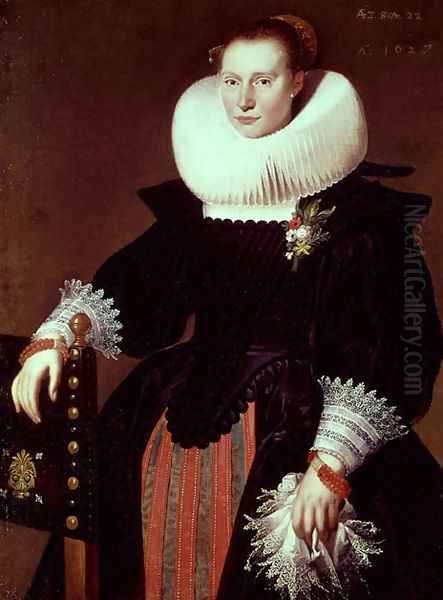
He also collaborated frequently with landscape specialist Jan Wildens (who became his brother-in-law) and the renowned animal and still-life painter Frans Snyders. In such collaborations, De Vos would typically paint the figures, while Wildens added the landscape backgrounds and Snyders contributed animals, fruit, or game. This practice allowed for high-quality results across different elements of the composition. His brother, Paul de Vos, also an accomplished painter specializing in dynamic hunting scenes and animal subjects, sometimes collaborated with him, further highlighting the familial and professional networks within the Antwerp art world. Other collaborators included Jan van den Hoecke, with whom he reportedly produced studio repetitions to meet market demand.
The Guild, Workshop, and Pupils
Cornelis de Vos's standing within the Antwerp artistic community was further cemented by his active role in the Guild of Saint Luke. He served as its Dean in 1619-1620, a position of considerable prestige and responsibility. The Dean oversaw the Guild's administration, upheld its standards, and represented its interests. His portrait of Abraham Grapheus was likely painted during or shortly after his deanship as a gift to the Guild, a testament to his commitment.
Like other successful masters, De Vos operated a workshop and trained apprentices. Running a workshop was crucial for handling commissions efficiently and passing on artistic knowledge. While documentation on all his pupils is incomplete, notable artists known or believed to have studied with him include Simon de Vos (no relation, despite the shared name) and the prominent painter Jan Cossiers (sometimes recorded as Jean Jossius). Training the next generation of artists was an integral part of the Guild system and contributed to the continuity of Antwerp's artistic traditions. His influence can be traced in the work of these and other painters active in the city during the mid-17th century.
Family Life and Artistic Connections
Family played a central role in Cornelis de Vos's life and art. In 1617, he married Susanna Cock, the half-sister of the landscape painter Jan Wildens. This marriage further integrated him into the close-knit community of Antwerp artists. Jan Wildens frequently collaborated with both De Vos and Rubens, painting landscape backgrounds for their figural compositions. Cornelis's own brother, Paul de Vos, was also a successful painter, specializing in large-scale animal paintings and hunting scenes, sometimes collaborating with Cornelis and Frans Snyders.
Cornelis and Susanna had several children, at least six of whom are known. As evidenced by his famous family portrait and individual depictions of his children, his family was a source of personal joy and artistic inspiration. These intimate portrayals suggest a man deeply invested in his domestic life, a theme that resonated well with the values of his bourgeois patrons. The frequent appearance of family members underscores the blurring of lines between personal life and professional practice common among artists of the period.
Later Years and Enduring Legacy
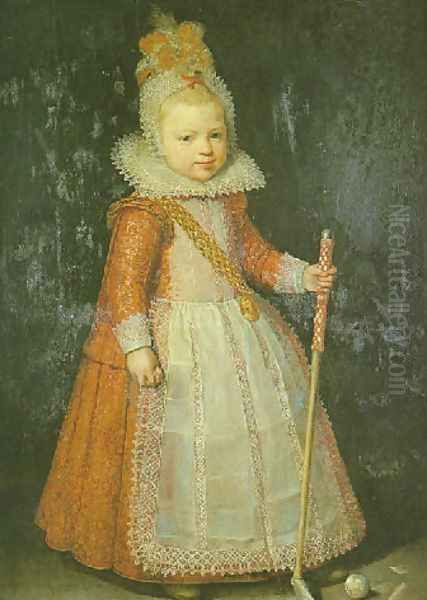
Cornelis de Vos remained active and respected throughout his career. He continued to receive important portrait commissions from Antwerp's elite and participated in collaborative projects. His style remained consistent, characterized by technical proficiency, warmth, and a sensitive approach to his subjects. He successfully navigated the competitive Antwerp art market, maintaining a prosperous career alongside giants like Rubens, Van Dyck, and Jordaens.
He died in Antwerp on May 9, 1651, and was buried in the city's Cathedral of Our Lady, a final mark of his esteemed position within the community. While his fame did not reach the international heights of Rubens or Van Dyck, and his name might be less recognized today outside of specialist circles or Belgium and the Netherlands, his contribution to Flemish Baroque art is undeniable. He was arguably the leading portrait painter in Antwerp during the period between Van Dyck's departures from the city and the rise of later specialists.
His works are preserved in major museums worldwide, including the Royal Museum of Fine Arts Antwerp, the Royal Museums of Fine Arts of Belgium in Brussels, the Prado Museum in Madrid, the Louvre in Paris, the Hermitage Museum in St. Petersburg, and numerous other collections in Europe and North America. His portraits, especially those of families and children, remain compelling for their blend of realism, elegance, and human warmth. They provide invaluable visual documentation of the society, fashion, and values of Antwerp during its 17th-century Golden Age.
Cornelis de Vos represents the solid, high-quality craftsmanship and artistic sensibility that formed the bedrock of the Antwerp school. He absorbed the innovations of his more famous contemporaries like Rubens, Van Dyck, and perhaps was aware of developments by Dutch masters like Frans Hals or even Spanish painters like Diego Velázquez through Antwerp's international connections, but he forged them into a style that was distinctly his own – refined, intimate, and deeply humane. He remains a key figure for understanding the breadth and depth of Flemish Baroque painting beyond its most celebrated names. His legacy lies in the quiet dignity and enduring appeal of his portrayals of the men, women, and children of his time.